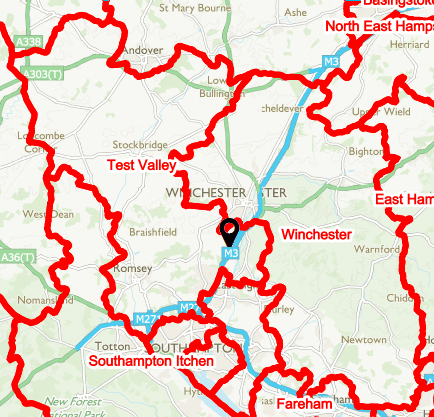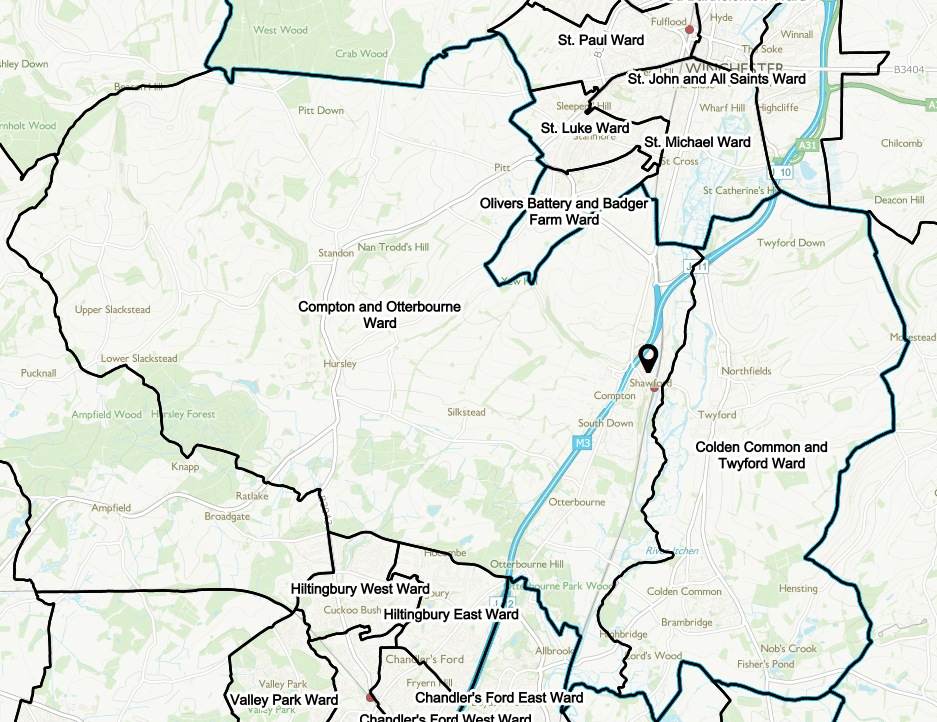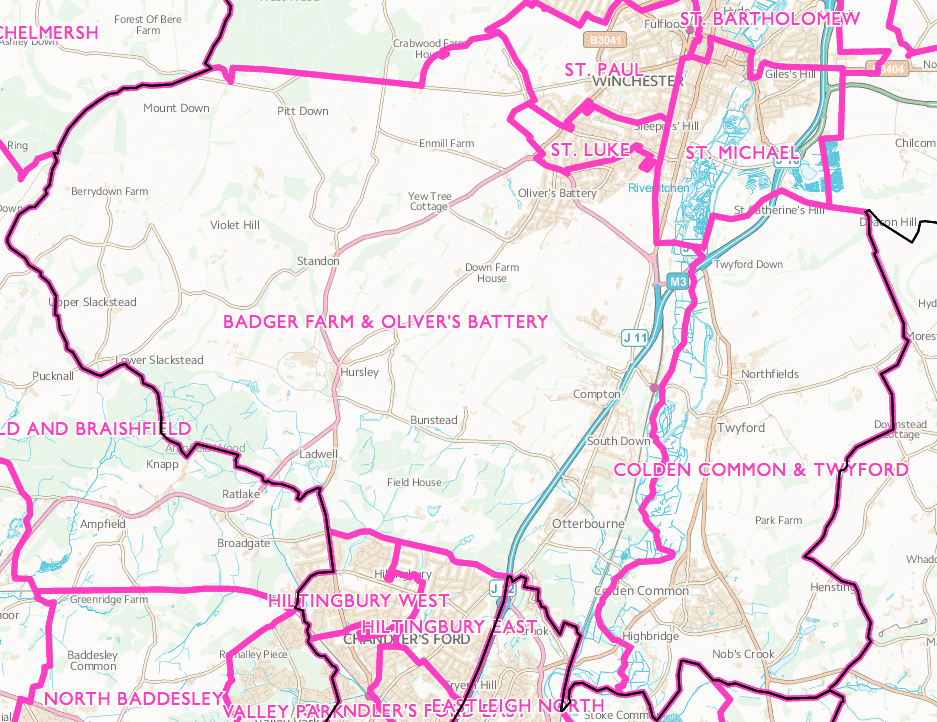Constituency boundary changes – this affects us
Parliamentary Constituency boundary changes
Table of Contents
Winchester or Test Valley? Last chance to influence the decision
- Should we stay in Winchester constituency or be transferred to Test Valley?
- As it stands, our parish is to become part of Test Valley constituency
- Whether or not you think we should stay in Winchester, you should send in your comments by Monday 11 December 2017.
Note: this is not about our current MP. The question is, from the next general election,
- do you want to be represented by the MP for Winchester?
- or by the MP for Test Valley who will most likely be Romsey-based?
Your comment should give reasons supporting your point of view.
There are many reasons to stay within Winchester constituency, including geographical, community, cultural and infrastructural links, and historical links which go back to Saxon times.
The PC letter to the Boundary Commission lists many of them. If you can think of even more reasons, please include them in your feedback to BCE.
Click on the tabs for a quick comparison of our existing constituency boundary with the initial and revised proposals for our area.
(if you want to drill into a more detailed map, use the BCE website . Use the “Boundaries” tab to choose any two levels of boundary to display.)
Winchester has expanded to the southeast to incorporate most of the large but sparsely populated Meon Valley constituency, which has disappeared.
The new Test Valley constituency incorporates most of the old Romsey and Southampton North constituency.
From the initial to the revised proposal, there has been no change to Winchester; a part of north New Forest East moved to Test Valley, and a small corridor along the M27 moved from the south end of Test Valley into New Forest East.



Parliament decided that the number of parliamentary constituencies must be cut to 600.
And
- By law, every constituency must contain between 71,031 and 78,507 electors
- that is, within +/- 5% of the “electoral quota” which is the total number of registered voters divided by the number of constituencies
- (the two Isle of Wight constituencies, and two Scottish Islands are special cases and not included in the quota calculation)
- the current electoral quota is 74,769
- The number of constituencies in the South East region must reduce from 84 to 83
In addition
- BCE largely uses local government wards as the building blocks for proposed constituencies.
Apart from “exceptional and compelling circumstances”, BCE has to use the ward boundaries which existed at the review date of 1 December 2015. So they have not taken into account our new ward boundary which came into effect in May 2016. - BCE tries to retain existing constituencies where possible
- BCE also tries to have regard to geographic factors
The House of Commons Political and Constitutional Reform Committee looked into the legislation for redrawing parliamentary boundaries.
Their report, dated 9 March 2015, included the following:
The primary reason for the unsatisfactory nature of the proposals brought forward during the 2013 review of parliamentary constituency boundaries was the strict arithmetic rule regarding the electorates of all but four constituencies—that they be within +/- 5% of the average constituency size of the UK. That said, we have noted the current wide variation in the number of registered electors from constituency to constituency, and concluded that it would be desirable for that to be reduced. The evidence we have received is that increasing the allowable variance to +/- 10% would, in the vast majority of cases, alleviate the challenges experienced during the 2013 Review.
We recommend that the allowable variance for the electorate of each constituency from the UK electoral quota be increased to +/- 10%. This would better enable the Commissions to come forward with more satisfactory proposals for new parliamentary constituencies, whilst still ensuring a greater degree of equality than exists at present in terms of the number of electors in each constituency. This change would require primary legislation.
and
Although local government wards are a perfectly sensible starting point for building parliamentary constituencies, the constraints created by the new rules for the distribution of parliamentary constituencies mean that Boundary Commissions cannot afford to bind themselves unnecessarily. We welcome the statement from the Boundary Commission for England that it will be more open to the possibility of splitting wards in the future. This should serve to minimise any unnecessary disruption resulting from the boundary review process, and allow for greater account to be taken of substantive community boundaries.
The submission from the Secretary to the Boundary Commission for England pointed out that the +/-5% rule would cause problems.
“The smaller you make the tolerance level from the actual quota, the harder it becomes to take into account properly the other factors that are mentioned in the Act, such as not breaking local ties, respecting local authority boundaries, and minimising change.” And as a consequence of the 5% rule, the Commission “quite often had to decide to set those other factors aside because the only mandatory one, as far as England was concerned, was the numerical one.”
You can download the full text of What next on the redrawing of parliamentary constituency boundaries? (House of Commons Political and Constitutional Reform Committee, Eighth Report of Session 2014–15)
Local comments and BCE’s response
Our neighbouring parishes, Hursley and Otterbourne (members with us of the old Compton & Otterbourne ward), had suggested that the wards of Compton & Otterbourne and Twyford & Colden Common be retained in Winchester Constituency. That would have needed a compensating move of other wards from Winchester to Test Valley.
The BCE revised proposal says:
“3.102 There were also objections to the inclusion of Compton and Otterbourne ward and Colden Common and Twyford ward in the proposed Test Valley constituency, citing close ties of these wards to Winchester. Adrian Walmsley (BCE-23497) proposed a solution that split the Compton and Otterbourne ward, so that just the polling district containing the Compton and Shawford Parish Council could be transferred back to Winchester.
While recognising the community links between Winchester and areas to its south and west, our assistant commissioners did not feel that there were sufficiently compelling reasons to justify the suggested splitting of the Compton and Otterbourne ward.
An alternative proposal from Hursley Parish Council (BCE-25257) was to transfer Sparsholt ward and Wonston and Micheldever ward to the Test Valley constituency in place of Compton and Otterbourne ward and Colden Common and Twyford ward.
In considering the counter-proposals to swap wards north of Winchester for those south of the city, the assistant commissioners advised us that this would merely be relocating the issue, and therefore did not recommend adopting these changes. In the absence of further evidence we are therefore not minded to alter our initial proposals in this area.”
The BCE response is open to the interpretation that if we produce more compelling reasons they would still consider splitting the (now obsolete) Compton & Otterbourne ward. This is a late change that they could accommodate, since there would be no knock-on effects. See electoral arithmetic below.
The story so far
This review follows the recent reviews by the Local Government Boundary Commission for England into our district ward boundaries and our county division boundaries, where the commissioners had accepted our request to become part of a five parish ward with Otterbourne, Hursley, Olivers Battery and Badger Farm rather than a large ward extending east as far as the West Meon Hut.
- BCE published their initial proposals for parliamentary constituency boundary changes in September 2016.
- The first consultation period closed on 5 December 2016.
- All comments received were available on the BCE website on 27 February 2017. The BCE website was open for another month to allow comments on the submissions.
- BCE’s revised proposals were published on 17 October 2017
- After the final consultation period ends on 11 December 2017, the BCE will review its proposals again in the light of comments received.
- Then it will decide what, if any further changes to make before, in September 2018, submitting its final recommendation for government approval.
- The timescale was set so that the new boundaries would come into effect for the General Election which would have been in 2020 if parliament had stuck to the fixed five-year term rule
Ward boundaries
In deciding on new constituency boundaries, BCE has to try to avoid splitting district wards as they existed in 2015.
In some cases, where boundaries have since changed, BCE can consider current wards. It’s true, as BCE pointed out, that moving Compton & Shawford parish into Winchester would split the (now obsolete) ward of Compton & Otterbourne. Our current 5-parish ward, now called Badger Farm and Oliver’s Battery, would be split by the BCE proposals; adopting our suggestion would merely mean the ward split 3-2 rather than 2-3 between Winchester and Test Valley.
Click on the tabs to see the current and previous ward boundaries, and the parish/polling district boundaries.
It is possible to move Compton & Shawford parish from Test Valley into Winchester without any knock-on effects, as shown in the table below.
Winchester would stay below the upper limit on constituency size and Test Valley would not fall below the lower limit.
Table 1: constraints
| C&S parish electorate (WM district) | 1,340 |
| Electoral quota | 74,769 |
| Max constituency | 78,507 |
| Min constituency | 71,031 |
Table 2: effect of relocating WM polling district to Winchester
| BCE initial proposal | BCE revised proposal | Move CSPC to Winchester | Compared to quota | |
| Winchester BC | 76,083 | 76,083 | 77,423 | 3.5% |
| Test Valley CC | 74,805 | 75,481 | 74,141 | -0.8% |
What is the Parish Council’s view now?
The Parish Council strongly opposed the proposal to move our parish out of the Winchester constituency and make us part of the Test Valley.
See the PC letter to the Boundary Commission .
Their response to the revised proposals will be an agenda item for the Parish Council meeting on 7 November 2017. If you would like the Parish Council to take your views into account when forming its own opinion, please contact the clerk.
Update 4 December 2017: CS PC submission to BCE Boundary Review now available
Links
- 2018 Boundary Review main site www.bce2018.org.uk/
- Summary – Revised proposals for new Parliamentary constituency boundaries in the South East
- Report – Revised proposals for new Parliamentary constituency boundaries in the South East
- Parish Council feedback to initial proposal
- Guide to the 2018 review
- Create Informed Representation
- FAQs for the 2018 Review
- What next on the redrawing of parliamentary constituency boundaries? (Eighth Report of Session 2014–15 of the House of Commons Political and Constitutional Reform Committee )
- On this site: posts relating to BCE
This is a greatly expanded version of a short article on page 27 of the November 2017 issue of the Compton & Shawford Parish Magazine.




